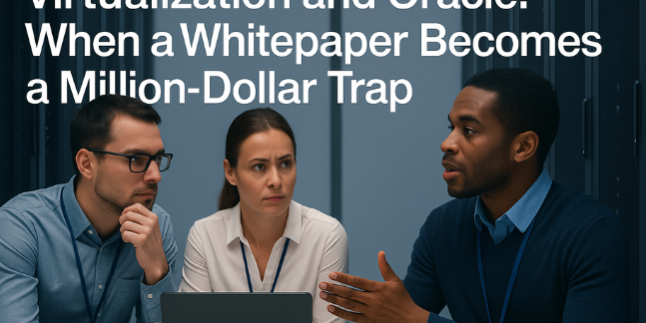Oracle’s Partitioning Policy isn’t law—but ignoring it can cost millions. Learn how to protect your VMware environment.
The Hidden Cost of Virtualization
Virtualization should simplify your IT environment—providing flexibility, scalability, and lower infrastructure costs.
But when Oracle software runs in a VMware or cloud environment, that same efficiency can trigger one of the most expensive compliance pitfalls in enterprise IT.
For more than a decade, Oracle has argued that every processor on which its software could theoretically run must be licensed. This interpretation comes from Oracle’s Partitioning Policy Whitepaper—a document frequently referenced during audits and negotiations.
Here’s the problem:
That whitepaper is not part of your contract, and even Oracle admits it is for educational purposes only.
Despite this, countless organizations have received multi-million-dollar “non-compliance” findings based entirely on that document. Understanding why—and how to defend yourself—is critical before Oracle’s auditors come calling.
Oracle’s FUD Playbook: Fear, Uncertainty, and Doubt
Oracle’s audit and account teams operate as commercial sales organizations, not as compliance authorities. Their compensation depends on revenue—so their goal is to expand license counts, not clarify contracts.
An Oracle “review” often begins innocently:
- How many VMware clusters do you operate?
- Which hypervisors are in use?
- Can you share your vCenter configuration?
Each question builds a picture of your infrastructure. Once Oracle learns the total number of cores available across your VMware environment, it applies its soft partitioning logic—claiming that the software could run on every host.
It’s not uncommon for organizations running Oracle on a small, isolated cluster to suddenly face multi-million-dollar claims once Oracle’s scripts detect a larger vCenter environment. What starts as a 40-core deployment can be treated as a 300-core infrastructure—with a corresponding “non-compliance” value attached. The result: confusion, internal panic, and pressure to settle quickly—before the situation is even fully understood.
What Oracle’s Own Whitepaper Really Says
Oracle’s Partitioning Policy Whitepaper includes a disclaimer many clients overlook: “This document is for educational purposes only and does not constitute a contract.” That single sentence undermines the legal foundation of Oracle’s entire “license every core” position.
Your binding contract—usually the Oracle License and Services Agreement (OLSA or OMA)—only requires you to license: “Processors where the Oracle Programs are installed and/or running.” Nowhere does it mention “processors where the software could run.” That small wording difference is the line between a manageable compliance position and a financial disaster.
Why Oversharing Information Backfires
Oracle’s audit tools and scripts often collect far more data than necessary to verify compliance. Unless restricted, they can extract complete vCenter or cloud-infrastructure details, including environments unrelated to Oracle. Once Oracle incorporates this information into its internal revenue forecast, your “compliance issue” becomes a sales opportunity—not a neutral assessment.
At that point, the challenge isn’t proving your compliance; it’s convincing Oracle to remove the potential deal from its quarterly pipeline.
This is where experienced guidance makes a decisive difference. Former Oracle auditors know precisely which data points are relevant—and which are traps designed to inflate exposure.
Staying in Control: Five Proven Defenses
- Read the fine print.
Oracle’s own documentation states it is non-binding. That’s your first and strongest defense. - Challenge every audit question.
Ask: “Which clause in our contract makes this relevant?”—a simple question that often stops overreach in its tracks. - Restrict audit access.
Use temporary admin accounts that expose only the systems where Oracle is installed and actively running. - Train your teams.
System administrators, DBAs, and procurement staff must know when—and when not—to respond to Oracle’s requests. - Run a friendly audit first.
License Consulting’s internal audit simulations reveal your real compliance position long before Oracle does.
The Hard vs. Soft Partitioning Debate
Oracle officially recognizes certain “hard partitioning” technologies that can isolate processor cores—such as Oracle Linux KVM with CPU pinning.
VMware, however, remains classified as “soft partitioning.” This means Oracle auditors typically treat all hosts within a vSphere cluster as licensable, unless your environment is clearly segregated and supported by precise documentation. While this interpretation is highly disputed across the industry, most organizations prefer to engineer their environments defensively—ensuring isolation and audit-ready evidence rather than relying on post-audit negotiation.
Prevention Is Cheaper Than Panic
Once Oracle assigns a “non-compliance” value to your account, it becomes part of their sales forecast—and the pressure to close that revenue is immense.
Avoiding that scenario is far easier, and far less expensive, than trying to reverse it. Remember: Oracle is a vendor, not a regulator.
You are under no obligation to answer every question or provide every log file—especially if it isn’t required by your contract. If you’re virtualizing Oracle workloads, take control of your compliance narrative now.
Because a whitepaper isn’t law—but ignoring it can still cost you millions.
A Smarter Way to Stay Ahead
The best defense against Oracle’s audit playbook is preparation.
Conduct a friendly audit to assess your true compliance position, document your architecture, and educate your team on how to handle Oracle’s inquiries. Engage experts who have been on both sides of the table—former Oracle auditors who know exactly how these audits unfold and what triggers a claim. Their insight turns fear into foresight.
👉 Contact License Consulting to schedule a friendly audit or workshop, and stay one step ahead of Oracle before the next audit arrives.














